Sustainability Management Plan: Residential Building Design Project
VerifiedAdded on 2021/05/30
|26
|5368
|437
Project
AI Summary
This sustainability management plan details the design and construction of a residential building at 37 Nathalia Street, Broadmeadows, focusing on environmental sustainability. The plan covers various aspects, including passive design features such as orientation and shading to maximize energy efficiency. It addresses construction materials, emphasizing the use of sustainable and recycled materials to minimize embodied energy and carbon emissions. Indoor environmental quality is a key consideration, with strategies to ensure a healthy living environment. Operational energy protection procedures, including solar panels and efficient appliances, are implemented to reduce energy consumption. Water resources are managed through rainwater harvesting, greywater recycling, and water-efficient fixtures. The plan also addresses stormwater management, building materials selection, and waste management strategies, including life cycle assessments and urban ecology considerations. The project emphasizes collaboration and innovation to achieve a sustainable and environmentally responsible design.
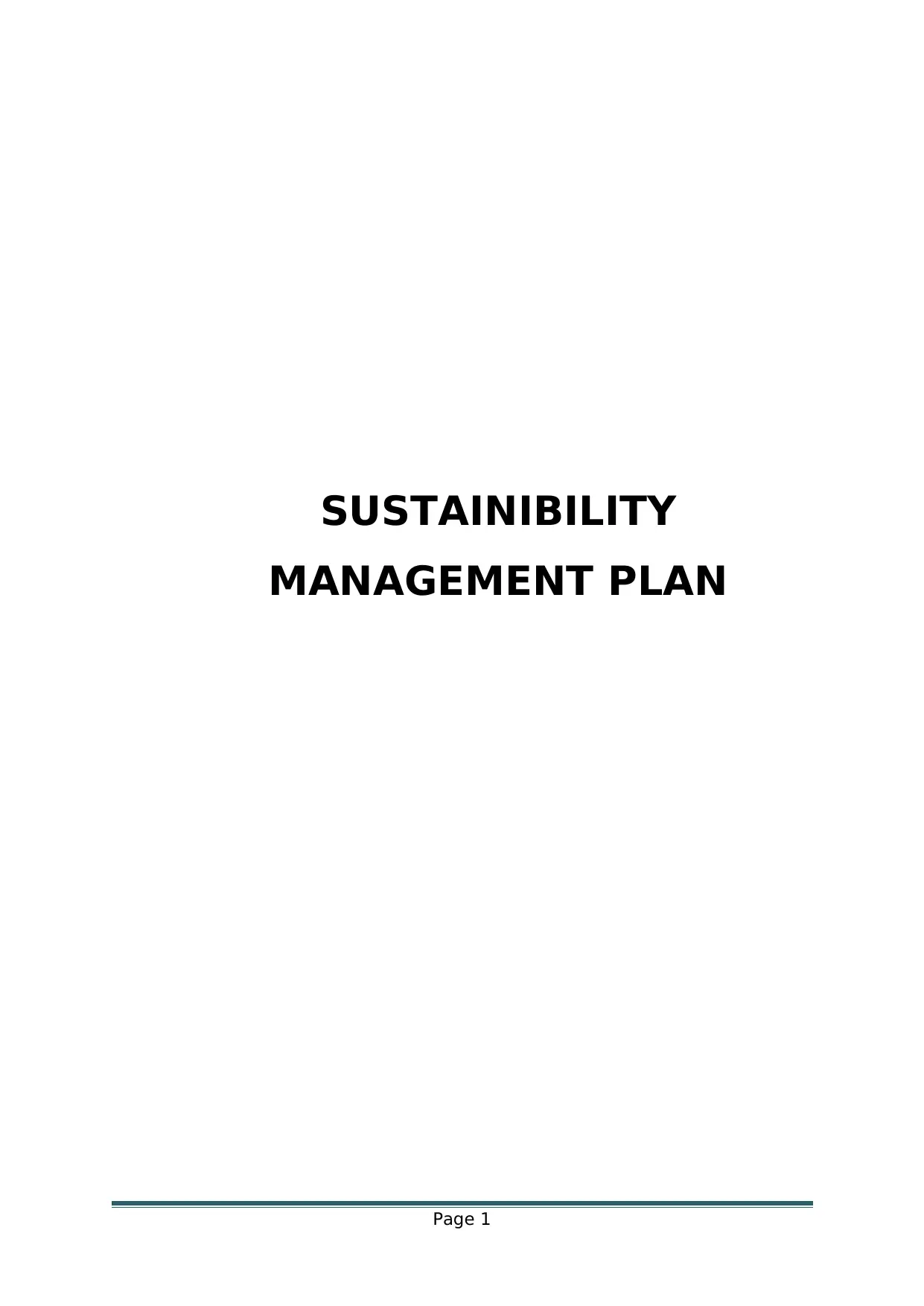
SUSTAINIBILITY
MANAGEMENT PLAN
Page 1
MANAGEMENT PLAN
Page 1
Paraphrase This Document
Need a fresh take? Get an instant paraphrase of this document with our AI Paraphraser

Table of Contents
1. Vision:............................................................................................................................3
Aim......................................................................................................................................3
Introduction: .......................................................................................................................3
2. Design
Brief: ..................................................................................................................3
2.1. 2DPlan for Residential Building.........................................................................3
2.2. Location Specification:.................................................................................4,5,6
2.3. Dwelling Type: ..................................................................................................6
2.4. Construction Material:.......................................................................................6
3. Passive Design Features: ...............................................................................................6
3.1. Orientation:.......................................................................................................6
3.2. Overhanging shading: .......................................................................................6
3.3. Insulation:.......................................................................................................6,7
4. Embodied Energy and Carbon the Lifecycle of a Building:............................................7
5. Indoor Environment Quality:.........................................................................................7
5.1. Factors considered for High Indoor Environment Quality:................................7
6. Operational energy protection procedure:...................................................................8
7. Energy Consumption:....................................................................................................8
7.1. Water Recourses:..............................................................................................8
8. Portable Water Conversation: ......................................................................................9
8.1. Average Water Usage: ......................................................................................9
8.2. Portable Water Conversation/ Recycling:..........................................................9
9. Storm Water Management:........................................................................................10
9.1. Rain Water Tank:.............................................................................................10
9.2. Rain Water Tank Adopted: ..............................................................................10
9.3. Grey Water Recycling Tank: ............................................................................10
9.4. Water Usage: ..................................................................................................11
9.5. Rain Garden: ...................................................................................................11
9.6. Reducing water demand: ................................................................................12
9.7. The Wells product rating system: ...................................................................12
9.8. Installing water meter to save water and resources: .....................................13
10. Storm Water Management: ........................................................................................13
11. Building Materials: ......................................................................................................13
12. Waste Management: ..................................................................................................14
12.1 Life Cycle and Waste: ......................................................................................15
12.2 Urban Ecology: ................................................................................................15
13.1 Green Rooftops and Dividers : ........................................................................15
13.2 Wind Factor: ...................................................................................................16
13.3 Building Innovation Through Collaboration: ..............................................16,17
14. Sustainability/ Green
Building:...................................................................................................18,19,20,21,22
Page 2
1. Vision:............................................................................................................................3
Aim......................................................................................................................................3
Introduction: .......................................................................................................................3
2. Design
Brief: ..................................................................................................................3
2.1. 2DPlan for Residential Building.........................................................................3
2.2. Location Specification:.................................................................................4,5,6
2.3. Dwelling Type: ..................................................................................................6
2.4. Construction Material:.......................................................................................6
3. Passive Design Features: ...............................................................................................6
3.1. Orientation:.......................................................................................................6
3.2. Overhanging shading: .......................................................................................6
3.3. Insulation:.......................................................................................................6,7
4. Embodied Energy and Carbon the Lifecycle of a Building:............................................7
5. Indoor Environment Quality:.........................................................................................7
5.1. Factors considered for High Indoor Environment Quality:................................7
6. Operational energy protection procedure:...................................................................8
7. Energy Consumption:....................................................................................................8
7.1. Water Recourses:..............................................................................................8
8. Portable Water Conversation: ......................................................................................9
8.1. Average Water Usage: ......................................................................................9
8.2. Portable Water Conversation/ Recycling:..........................................................9
9. Storm Water Management:........................................................................................10
9.1. Rain Water Tank:.............................................................................................10
9.2. Rain Water Tank Adopted: ..............................................................................10
9.3. Grey Water Recycling Tank: ............................................................................10
9.4. Water Usage: ..................................................................................................11
9.5. Rain Garden: ...................................................................................................11
9.6. Reducing water demand: ................................................................................12
9.7. The Wells product rating system: ...................................................................12
9.8. Installing water meter to save water and resources: .....................................13
10. Storm Water Management: ........................................................................................13
11. Building Materials: ......................................................................................................13
12. Waste Management: ..................................................................................................14
12.1 Life Cycle and Waste: ......................................................................................15
12.2 Urban Ecology: ................................................................................................15
13.1 Green Rooftops and Dividers : ........................................................................15
13.2 Wind Factor: ...................................................................................................16
13.3 Building Innovation Through Collaboration: ..............................................16,17
14. Sustainability/ Green
Building:...................................................................................................18,19,20,21,22
Page 2
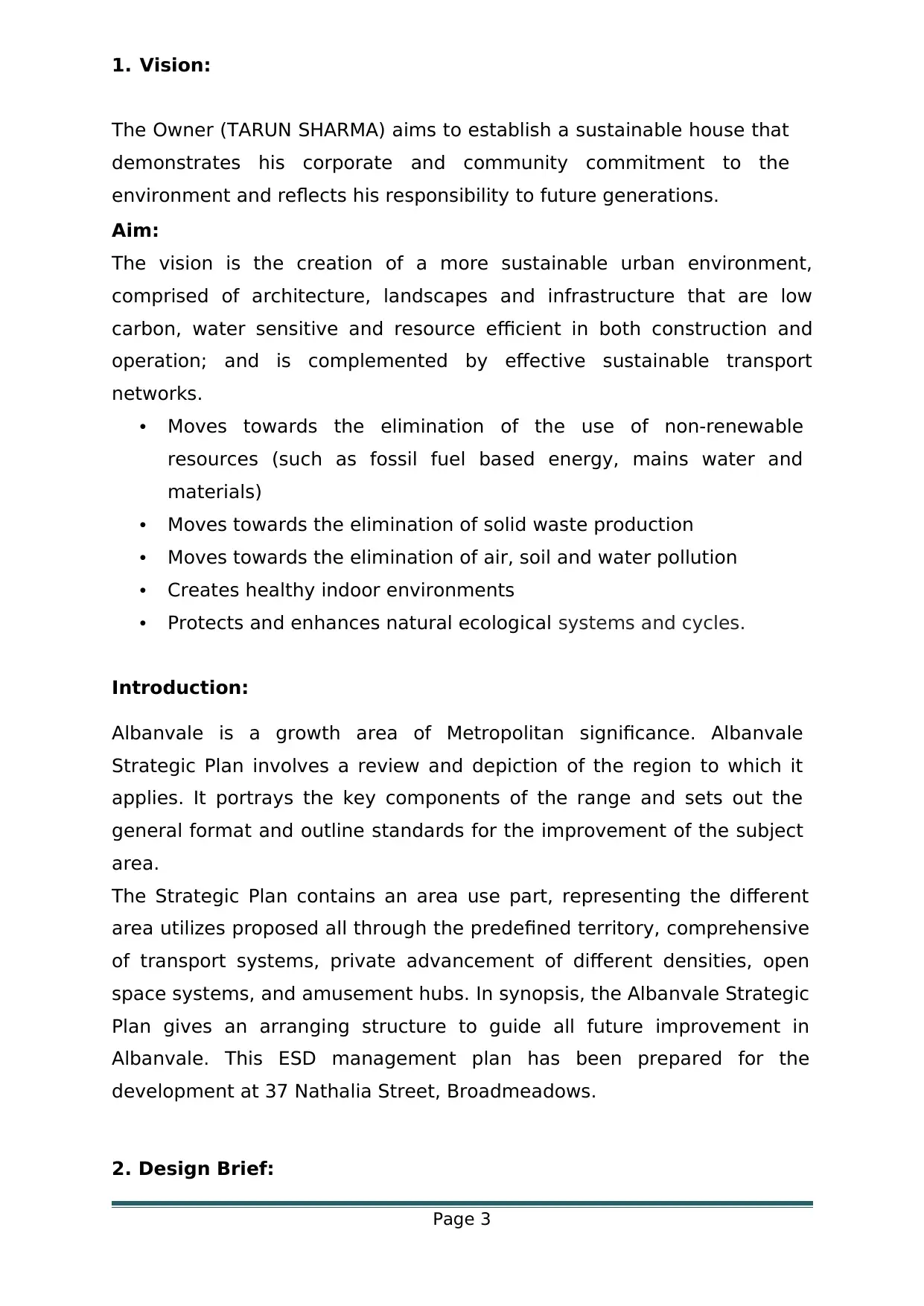
1. Vision:
The Owner (TARUN SHARMA) aims to establish a sustainable house that
demonstrates his corporate and community commitment to the
environment and reflects his responsibility to future generations.
Aim:
The vision is the creation of a more sustainable urban environment,
comprised of architecture, landscapes and infrastructure that are low
carbon, water sensitive and resource efficient in both construction and
operation; and is complemented by effective sustainable transport
networks.
• Moves towards the elimination of the use of non-renewable
resources (such as fossil fuel based energy, mains water and
materials)
• Moves towards the elimination of solid waste production
• Moves towards the elimination of air, soil and water pollution
• Creates healthy indoor environments
• Protects and enhances natural ecological systems and cycles.
Introduction:
Albanvale is a growth area of Metropolitan significance. Albanvale
Strategic Plan involves a review and depiction of the region to which it
applies. It portrays the key components of the range and sets out the
general format and outline standards for the improvement of the subject
area.
The Strategic Plan contains an area use part, representing the different
area utilizes proposed all through the predefined territory, comprehensive
of transport systems, private advancement of different densities, open
space systems, and amusement hubs. In synopsis, the Albanvale Strategic
Plan gives an arranging structure to guide all future improvement in
Albanvale. This ESD management plan has been prepared for the
development at 37 Nathalia Street, Broadmeadows.
2. Design Brief:
Page 3
The Owner (TARUN SHARMA) aims to establish a sustainable house that
demonstrates his corporate and community commitment to the
environment and reflects his responsibility to future generations.
Aim:
The vision is the creation of a more sustainable urban environment,
comprised of architecture, landscapes and infrastructure that are low
carbon, water sensitive and resource efficient in both construction and
operation; and is complemented by effective sustainable transport
networks.
• Moves towards the elimination of the use of non-renewable
resources (such as fossil fuel based energy, mains water and
materials)
• Moves towards the elimination of solid waste production
• Moves towards the elimination of air, soil and water pollution
• Creates healthy indoor environments
• Protects and enhances natural ecological systems and cycles.
Introduction:
Albanvale is a growth area of Metropolitan significance. Albanvale
Strategic Plan involves a review and depiction of the region to which it
applies. It portrays the key components of the range and sets out the
general format and outline standards for the improvement of the subject
area.
The Strategic Plan contains an area use part, representing the different
area utilizes proposed all through the predefined territory, comprehensive
of transport systems, private advancement of different densities, open
space systems, and amusement hubs. In synopsis, the Albanvale Strategic
Plan gives an arranging structure to guide all future improvement in
Albanvale. This ESD management plan has been prepared for the
development at 37 Nathalia Street, Broadmeadows.
2. Design Brief:
Page 3
⊘ This is a preview!⊘
Do you want full access?
Subscribe today to unlock all pages.

Trusted by 1+ million students worldwide
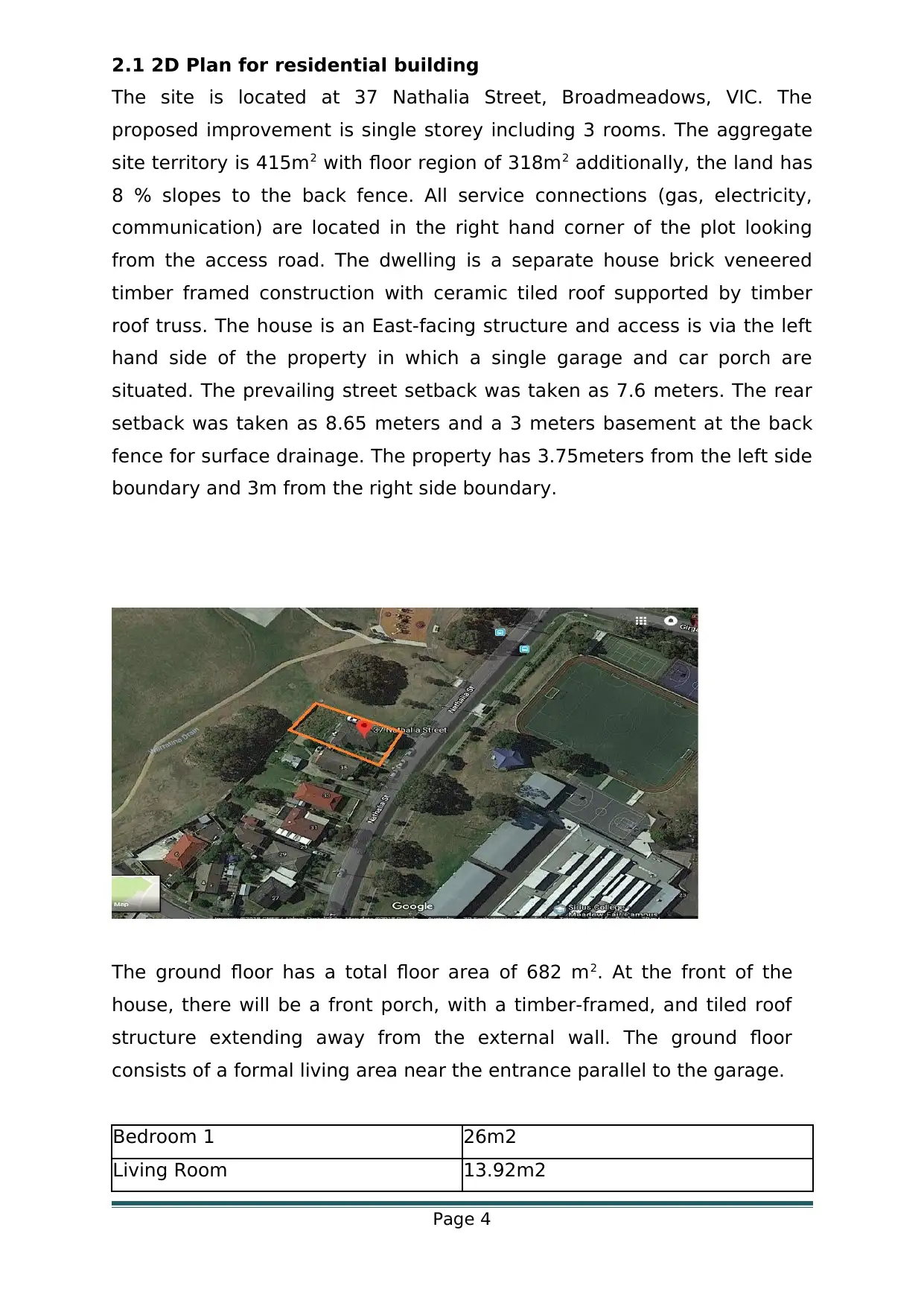
2.1 2D Plan for residential building
The site is located at 37 Nathalia Street, Broadmeadows, VIC. The
proposed improvement is single storey including 3 rooms. The aggregate
site territory is 415m2 with floor region of 318m2 additionally, the land has
8 % slopes to the back fence. All service connections (gas, electricity,
communication) are located in the right hand corner of the plot looking
from the access road. The dwelling is a separate house brick veneered
timber framed construction with ceramic tiled roof supported by timber
roof truss. The house is an East-facing structure and access is via the left
hand side of the property in which a single garage and car porch are
situated. The prevailing street setback was taken as 7.6 meters. The rear
setback was taken as 8.65 meters and a 3 meters basement at the back
fence for surface drainage. The property has 3.75meters from the left side
boundary and 3m from the right side boundary.
The ground floor has a total floor area of 682 m2. At the front of the
house, there will be a front porch, with a timber-framed, and tiled roof
structure extending away from the external wall. The ground floor
consists of a formal living area near the entrance parallel to the garage.
Bedroom 1 26m2
Living Room 13.92m2
Page 4
The site is located at 37 Nathalia Street, Broadmeadows, VIC. The
proposed improvement is single storey including 3 rooms. The aggregate
site territory is 415m2 with floor region of 318m2 additionally, the land has
8 % slopes to the back fence. All service connections (gas, electricity,
communication) are located in the right hand corner of the plot looking
from the access road. The dwelling is a separate house brick veneered
timber framed construction with ceramic tiled roof supported by timber
roof truss. The house is an East-facing structure and access is via the left
hand side of the property in which a single garage and car porch are
situated. The prevailing street setback was taken as 7.6 meters. The rear
setback was taken as 8.65 meters and a 3 meters basement at the back
fence for surface drainage. The property has 3.75meters from the left side
boundary and 3m from the right side boundary.
The ground floor has a total floor area of 682 m2. At the front of the
house, there will be a front porch, with a timber-framed, and tiled roof
structure extending away from the external wall. The ground floor
consists of a formal living area near the entrance parallel to the garage.
Bedroom 1 26m2
Living Room 13.92m2
Page 4
Paraphrase This Document
Need a fresh take? Get an instant paraphrase of this document with our AI Paraphraser
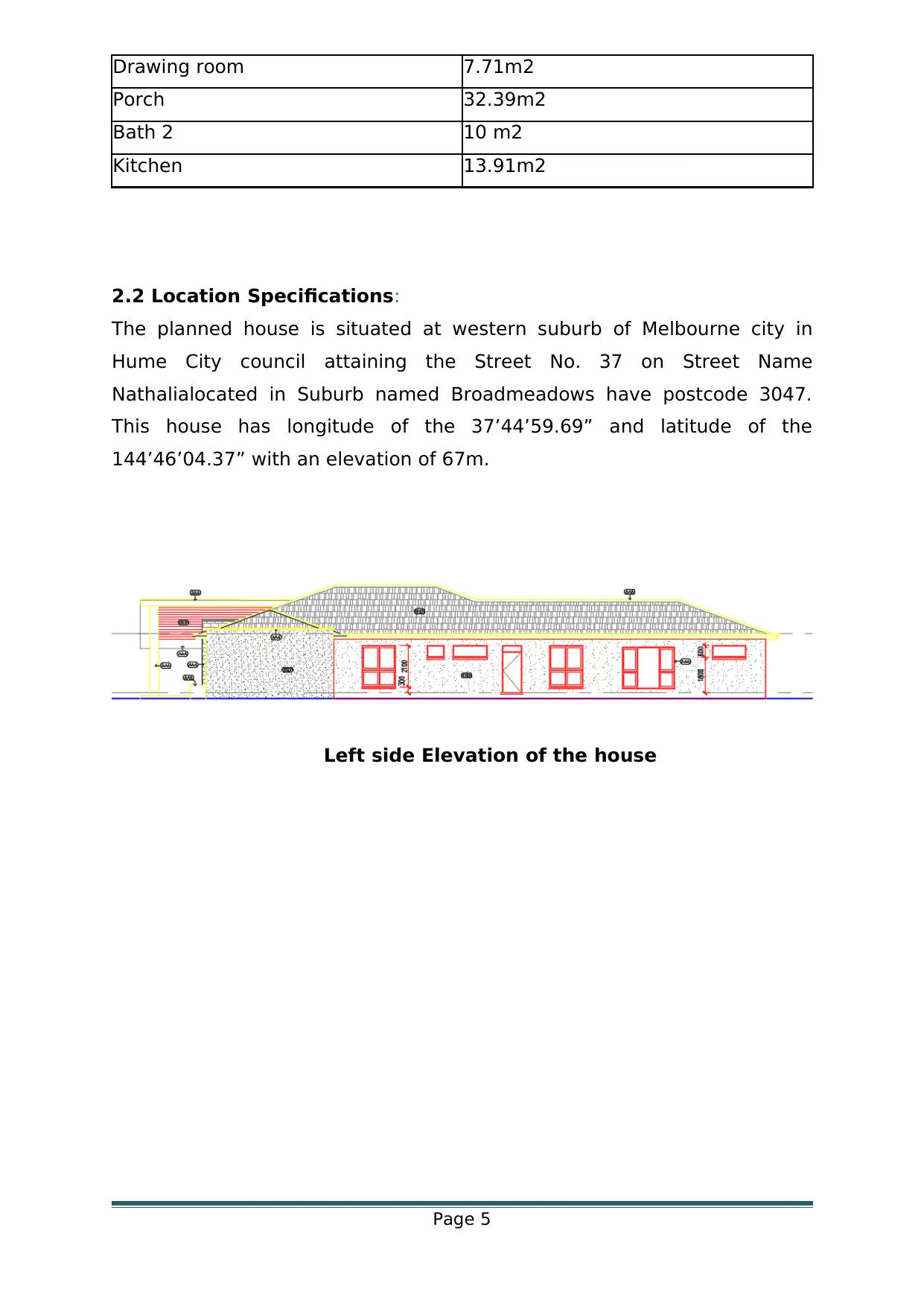
Drawing room 7.71m2
Porch 32.39m2
Bath 2 10 m2
Kitchen 13.91m2
2.2 Location Specifications:
The planned house is situated at western suburb of Melbourne city in
Hume City council attaining the Street No. 37 on Street Name
Nathalialocated in Suburb named Broadmeadows have postcode 3047.
This house has longitude of the 37’44’59.69” and latitude of the
144’46’04.37” with an elevation of 67m.
Left side Elevation of the house
Page 5
Porch 32.39m2
Bath 2 10 m2
Kitchen 13.91m2
2.2 Location Specifications:
The planned house is situated at western suburb of Melbourne city in
Hume City council attaining the Street No. 37 on Street Name
Nathalialocated in Suburb named Broadmeadows have postcode 3047.
This house has longitude of the 37’44’59.69” and latitude of the
144’46’04.37” with an elevation of 67m.
Left side Elevation of the house
Page 5

BACK ELEVATION OF THE PLAN
FRONT ELEVATION
Page 6
FRONT ELEVATION
Page 6
⊘ This is a preview!⊘
Do you want full access?
Subscribe today to unlock all pages.

Trusted by 1+ million students worldwide
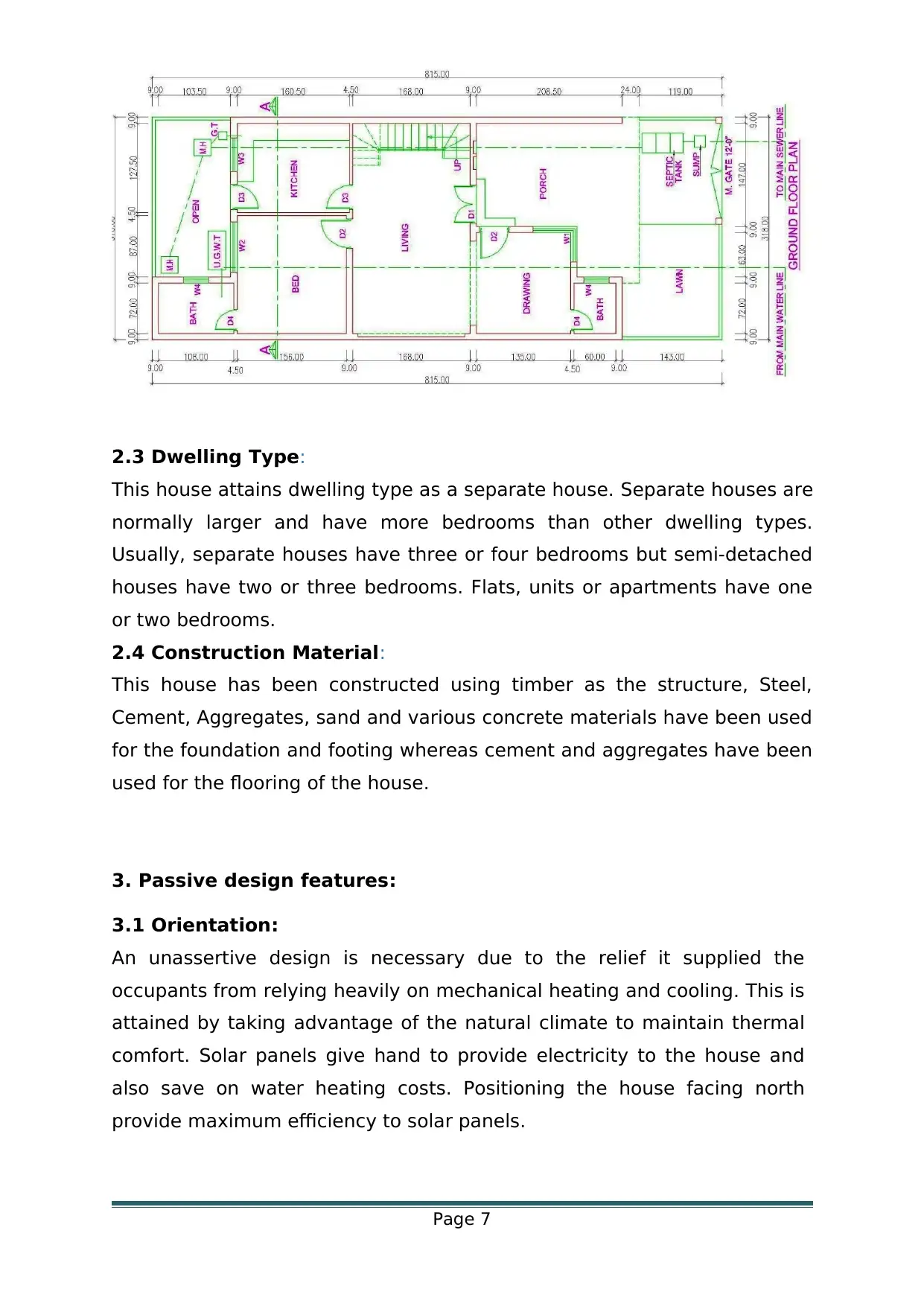
2.3 Dwelling Type:
This house attains dwelling type as a separate house. Separate houses are
normally larger and have more bedrooms than other dwelling types.
Usually, separate houses have three or four bedrooms but semi-detached
houses have two or three bedrooms. Flats, units or apartments have one
or two bedrooms.
2.4 Construction Material:
This house has been constructed using timber as the structure, Steel,
Cement, Aggregates, sand and various concrete materials have been used
for the foundation and footing whereas cement and aggregates have been
used for the flooring of the house.
3. Passive design features:
3.1 Orientation:
An unassertive design is necessary due to the relief it supplied the
occupants from relying heavily on mechanical heating and cooling. This is
attained by taking advantage of the natural climate to maintain thermal
comfort. Solar panels give hand to provide electricity to the house and
also save on water heating costs. Positioning the house facing north
provide maximum efficiency to solar panels.
Page 7
This house attains dwelling type as a separate house. Separate houses are
normally larger and have more bedrooms than other dwelling types.
Usually, separate houses have three or four bedrooms but semi-detached
houses have two or three bedrooms. Flats, units or apartments have one
or two bedrooms.
2.4 Construction Material:
This house has been constructed using timber as the structure, Steel,
Cement, Aggregates, sand and various concrete materials have been used
for the foundation and footing whereas cement and aggregates have been
used for the flooring of the house.
3. Passive design features:
3.1 Orientation:
An unassertive design is necessary due to the relief it supplied the
occupants from relying heavily on mechanical heating and cooling. This is
attained by taking advantage of the natural climate to maintain thermal
comfort. Solar panels give hand to provide electricity to the house and
also save on water heating costs. Positioning the house facing north
provide maximum efficiency to solar panels.
Page 7
Paraphrase This Document
Need a fresh take? Get an instant paraphrase of this document with our AI Paraphraser
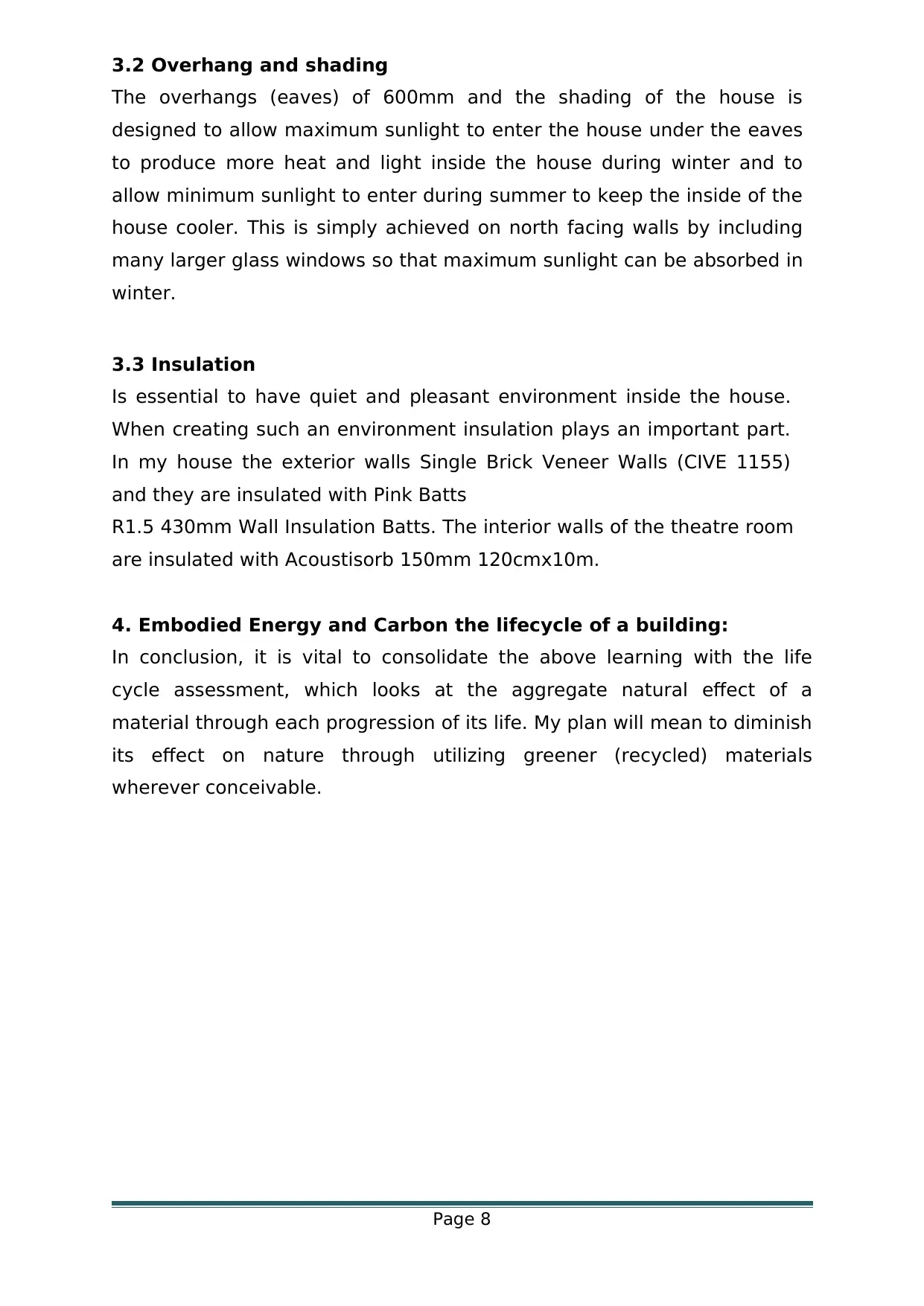
3.2 Overhang and shading
The overhangs (eaves) of 600mm and the shading of the house is
designed to allow maximum sunlight to enter the house under the eaves
to produce more heat and light inside the house during winter and to
allow minimum sunlight to enter during summer to keep the inside of the
house cooler. This is simply achieved on north facing walls by including
many larger glass windows so that maximum sunlight can be absorbed in
winter.
3.3 Insulation
Is essential to have quiet and pleasant environment inside the house.
When creating such an environment insulation plays an important part.
In my house the exterior walls Single Brick Veneer Walls (CIVE 1155)
and they are insulated with Pink Batts
R1.5 430mm Wall Insulation Batts. The interior walls of the theatre room
are insulated with Acoustisorb 150mm 120cmx10m.
4. Embodied Energy and Carbon the lifecycle of a building:
In conclusion, it is vital to consolidate the above learning with the life
cycle assessment, which looks at the aggregate natural effect of a
material through each progression of its life. My plan will mean to diminish
its effect on nature through utilizing greener (recycled) materials
wherever conceivable.
Page 8
The overhangs (eaves) of 600mm and the shading of the house is
designed to allow maximum sunlight to enter the house under the eaves
to produce more heat and light inside the house during winter and to
allow minimum sunlight to enter during summer to keep the inside of the
house cooler. This is simply achieved on north facing walls by including
many larger glass windows so that maximum sunlight can be absorbed in
winter.
3.3 Insulation
Is essential to have quiet and pleasant environment inside the house.
When creating such an environment insulation plays an important part.
In my house the exterior walls Single Brick Veneer Walls (CIVE 1155)
and they are insulated with Pink Batts
R1.5 430mm Wall Insulation Batts. The interior walls of the theatre room
are insulated with Acoustisorb 150mm 120cmx10m.
4. Embodied Energy and Carbon the lifecycle of a building:
In conclusion, it is vital to consolidate the above learning with the life
cycle assessment, which looks at the aggregate natural effect of a
material through each progression of its life. My plan will mean to diminish
its effect on nature through utilizing greener (recycled) materials
wherever conceivable.
Page 8
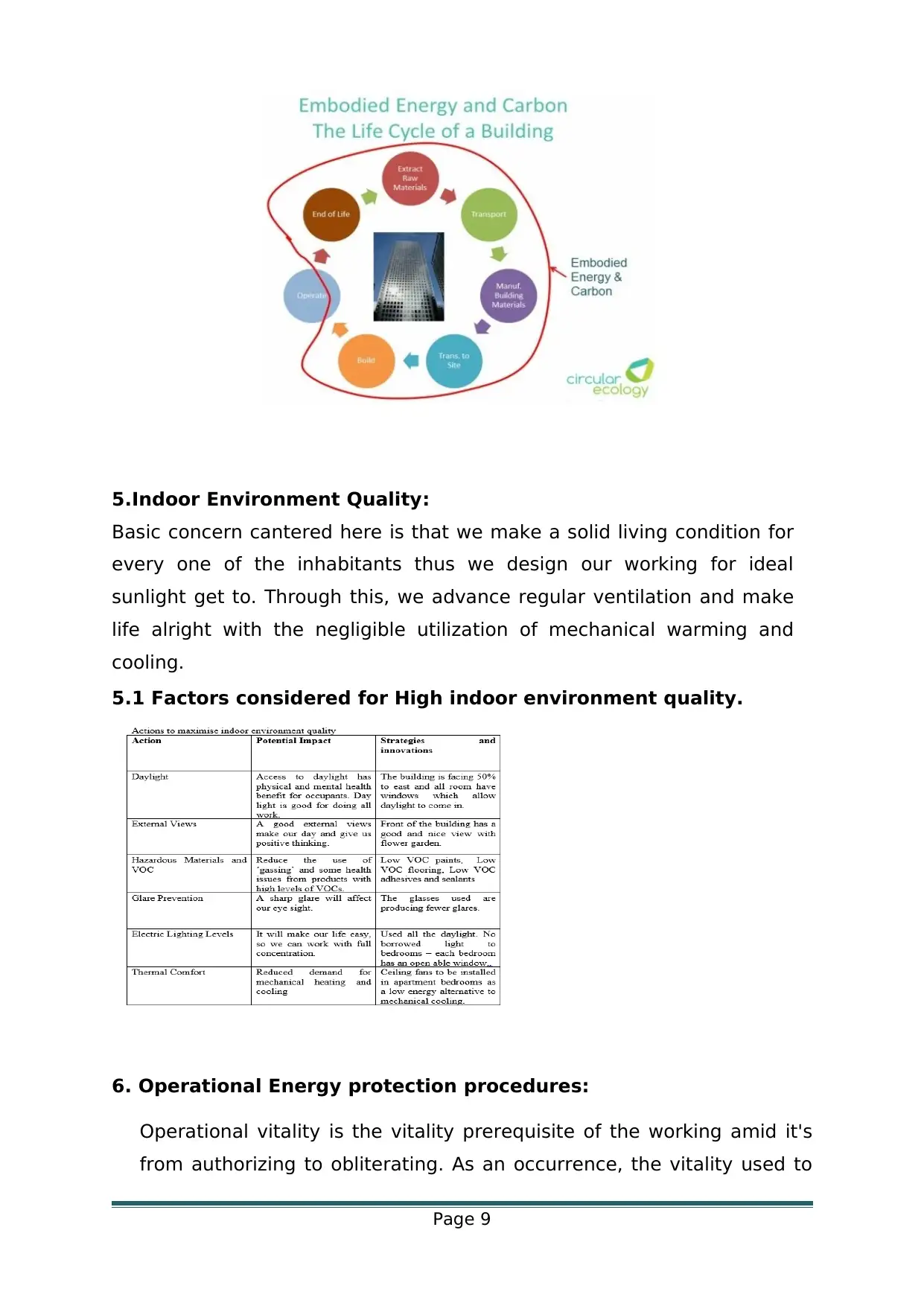
5.Indoor Environment Quality:
Basic concern cantered here is that we make a solid living condition for
every one of the inhabitants thus we design our working for ideal
sunlight get to. Through this, we advance regular ventilation and make
life alright with the negligible utilization of mechanical warming and
cooling.
5.1 Factors considered for High indoor environment quality.
6. Operational Energy protection procedures:
Operational vitality is the vitality prerequisite of the working amid it's
from authorizing to obliterating. As an occurrence, the vitality used to
Page 9
Basic concern cantered here is that we make a solid living condition for
every one of the inhabitants thus we design our working for ideal
sunlight get to. Through this, we advance regular ventilation and make
life alright with the negligible utilization of mechanical warming and
cooling.
5.1 Factors considered for High indoor environment quality.
6. Operational Energy protection procedures:
Operational vitality is the vitality prerequisite of the working amid it's
from authorizing to obliterating. As an occurrence, the vitality used to
Page 9
⊘ This is a preview!⊘
Do you want full access?
Subscribe today to unlock all pages.

Trusted by 1+ million students worldwide
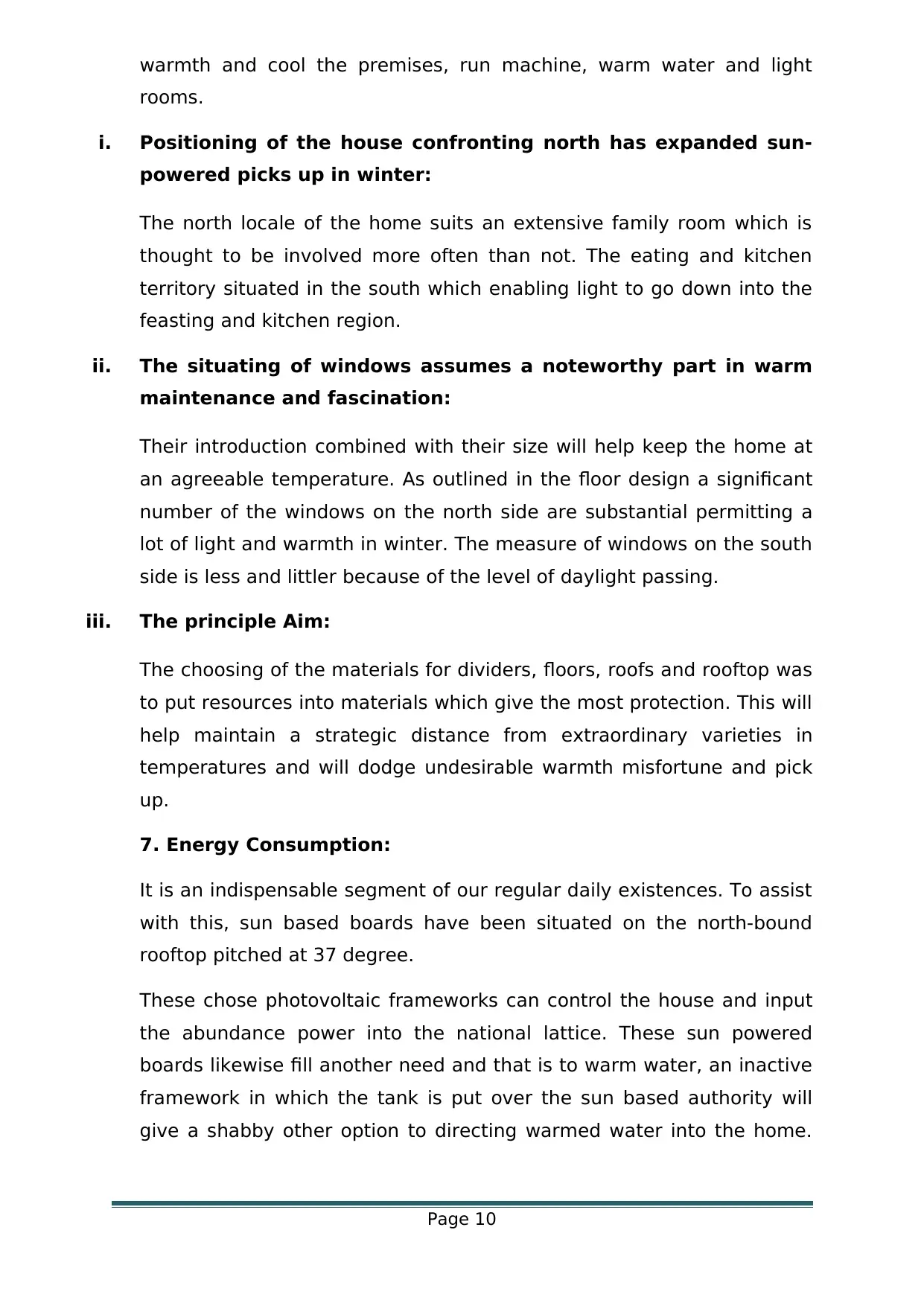
warmth and cool the premises, run machine, warm water and light
rooms.
i. Positioning of the house confronting north has expanded sun-
powered picks up in winter:
The north locale of the home suits an extensive family room which is
thought to be involved more often than not. The eating and kitchen
territory situated in the south which enabling light to go down into the
feasting and kitchen region.
ii. The situating of windows assumes a noteworthy part in warm
maintenance and fascination:
Their introduction combined with their size will help keep the home at
an agreeable temperature. As outlined in the floor design a significant
number of the windows on the north side are substantial permitting a
lot of light and warmth in winter. The measure of windows on the south
side is less and littler because of the level of daylight passing.
iii. The principle Aim:
The choosing of the materials for dividers, floors, roofs and rooftop was
to put resources into materials which give the most protection. This will
help maintain a strategic distance from extraordinary varieties in
temperatures and will dodge undesirable warmth misfortune and pick
up.
7. Energy Consumption:
It is an indispensable segment of our regular daily existences. To assist
with this, sun based boards have been situated on the north-bound
rooftop pitched at 37 degree.
These chose photovoltaic frameworks can control the house and input
the abundance power into the national lattice. These sun powered
boards likewise fill another need and that is to warm water, an inactive
framework in which the tank is put over the sun based authority will
give a shabby other option to directing warmed water into the home.
Page 10
rooms.
i. Positioning of the house confronting north has expanded sun-
powered picks up in winter:
The north locale of the home suits an extensive family room which is
thought to be involved more often than not. The eating and kitchen
territory situated in the south which enabling light to go down into the
feasting and kitchen region.
ii. The situating of windows assumes a noteworthy part in warm
maintenance and fascination:
Their introduction combined with their size will help keep the home at
an agreeable temperature. As outlined in the floor design a significant
number of the windows on the north side are substantial permitting a
lot of light and warmth in winter. The measure of windows on the south
side is less and littler because of the level of daylight passing.
iii. The principle Aim:
The choosing of the materials for dividers, floors, roofs and rooftop was
to put resources into materials which give the most protection. This will
help maintain a strategic distance from extraordinary varieties in
temperatures and will dodge undesirable warmth misfortune and pick
up.
7. Energy Consumption:
It is an indispensable segment of our regular daily existences. To assist
with this, sun based boards have been situated on the north-bound
rooftop pitched at 37 degree.
These chose photovoltaic frameworks can control the house and input
the abundance power into the national lattice. These sun powered
boards likewise fill another need and that is to warm water, an inactive
framework in which the tank is put over the sun based authority will
give a shabby other option to directing warmed water into the home.
Page 10
Paraphrase This Document
Need a fresh take? Get an instant paraphrase of this document with our AI Paraphraser
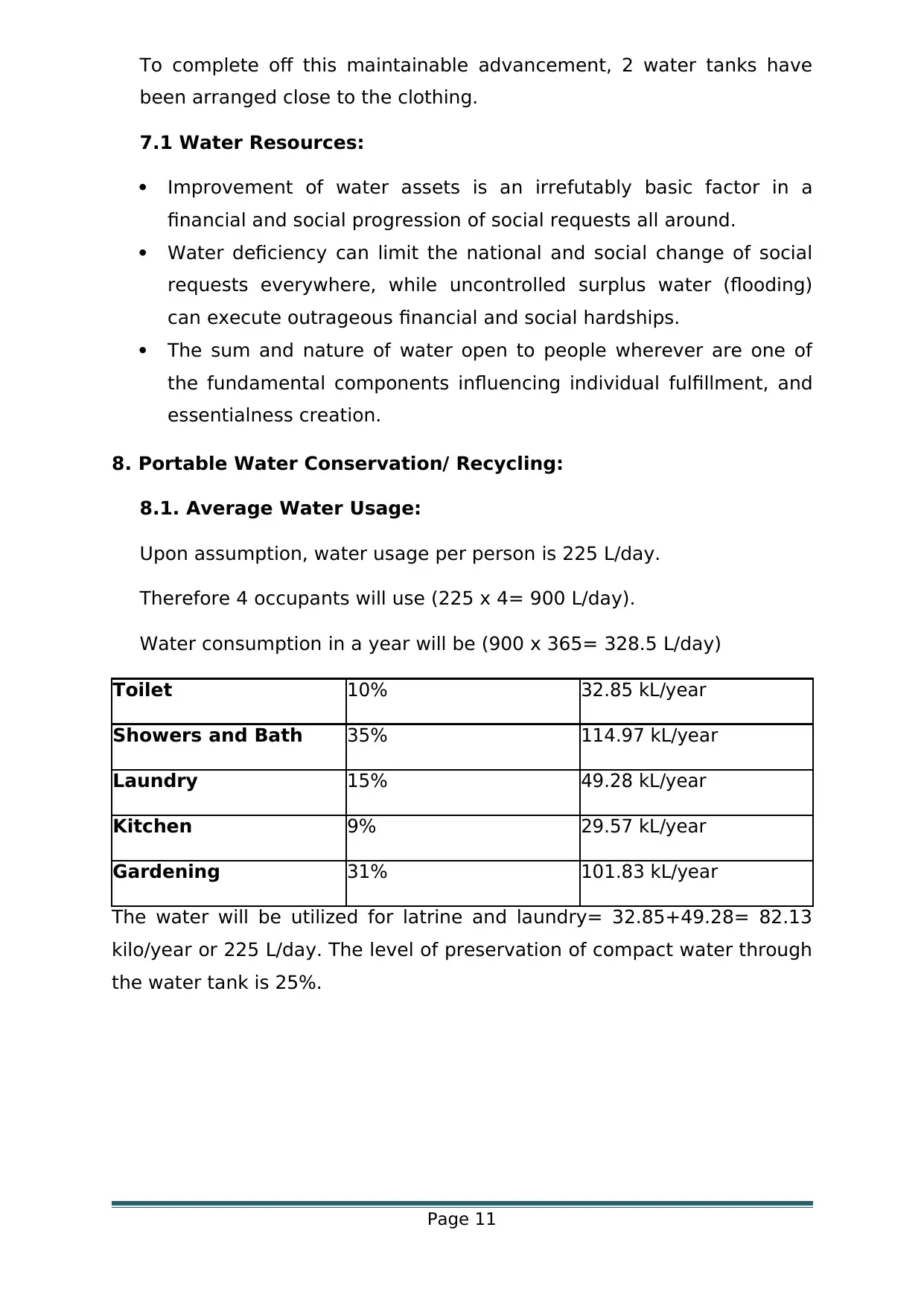
To complete off this maintainable advancement, 2 water tanks have
been arranged close to the clothing.
7.1 Water Resources:
Improvement of water assets is an irrefutably basic factor in a
financial and social progression of social requests all around.
Water deficiency can limit the national and social change of social
requests everywhere, while uncontrolled surplus water (flooding)
can execute outrageous financial and social hardships.
The sum and nature of water open to people wherever are one of
the fundamental components influencing individual fulfillment, and
essentialness creation.
8. Portable Water Conservation/ Recycling:
8.1. Average Water Usage:
Upon assumption, water usage per person is 225 L/day.
Therefore 4 occupants will use (225 x 4= 900 L/day).
Water consumption in a year will be (900 x 365= 328.5 L/day)
Toilet 10% 32.85 kL/year
Showers and Bath 35% 114.97 kL/year
Laundry 15% 49.28 kL/year
Kitchen 9% 29.57 kL/year
Gardening 31% 101.83 kL/year
The water will be utilized for latrine and laundry= 32.85+49.28= 82.13
kilo/year or 225 L/day. The level of preservation of compact water through
the water tank is 25%.
Page 11
been arranged close to the clothing.
7.1 Water Resources:
Improvement of water assets is an irrefutably basic factor in a
financial and social progression of social requests all around.
Water deficiency can limit the national and social change of social
requests everywhere, while uncontrolled surplus water (flooding)
can execute outrageous financial and social hardships.
The sum and nature of water open to people wherever are one of
the fundamental components influencing individual fulfillment, and
essentialness creation.
8. Portable Water Conservation/ Recycling:
8.1. Average Water Usage:
Upon assumption, water usage per person is 225 L/day.
Therefore 4 occupants will use (225 x 4= 900 L/day).
Water consumption in a year will be (900 x 365= 328.5 L/day)
Toilet 10% 32.85 kL/year
Showers and Bath 35% 114.97 kL/year
Laundry 15% 49.28 kL/year
Kitchen 9% 29.57 kL/year
Gardening 31% 101.83 kL/year
The water will be utilized for latrine and laundry= 32.85+49.28= 82.13
kilo/year or 225 L/day. The level of preservation of compact water through
the water tank is 25%.
Page 11

9. Storm Water Management:
Rainwater is absorbed and soaked into the ground and then it evaporates
from the surface taken up by plants or finding its way slowly into rivers or
streams. Any development will affect and make an impact on the
environment and change the natural water cycle.
9.1. Rain Water Tank:
Water can be gathered by using the rooftop space as a catchment
territory and steering the water into a water tank. Rainwater can be
utilized as a part of the can, clothing and planting purposes. As per the
rooftop design, accepting 60% of rooftop territory to catch rainwater. The
aggregate rooftop zone is 201.31m2 and catchment territory is 120.79m2.
The volume of yearly rain water which is caught by the rooftop is Annual
rainfall x catchment territory x coefficient of spill over.
Coefficient of overflow (is 10% of water lost because of dissipation and
other factor) =120.79m2 x 0.65m/year x 90% =70.66 kL/year or
116.16L/day.
9.2 Rain water tank adopted:
Slim line tanks Dimensions
2000 L 750W x 2900L x 1200H
Page 12
Rainwater is absorbed and soaked into the ground and then it evaporates
from the surface taken up by plants or finding its way slowly into rivers or
streams. Any development will affect and make an impact on the
environment and change the natural water cycle.
9.1. Rain Water Tank:
Water can be gathered by using the rooftop space as a catchment
territory and steering the water into a water tank. Rainwater can be
utilized as a part of the can, clothing and planting purposes. As per the
rooftop design, accepting 60% of rooftop territory to catch rainwater. The
aggregate rooftop zone is 201.31m2 and catchment territory is 120.79m2.
The volume of yearly rain water which is caught by the rooftop is Annual
rainfall x catchment territory x coefficient of spill over.
Coefficient of overflow (is 10% of water lost because of dissipation and
other factor) =120.79m2 x 0.65m/year x 90% =70.66 kL/year or
116.16L/day.
9.2 Rain water tank adopted:
Slim line tanks Dimensions
2000 L 750W x 2900L x 1200H
Page 12
⊘ This is a preview!⊘
Do you want full access?
Subscribe today to unlock all pages.

Trusted by 1+ million students worldwide
1 out of 26
Related Documents
Your All-in-One AI-Powered Toolkit for Academic Success.
+13062052269
info@desklib.com
Available 24*7 on WhatsApp / Email
![[object Object]](/_next/static/media/star-bottom.7253800d.svg)
Unlock your academic potential
Copyright © 2020–2025 A2Z Services. All Rights Reserved. Developed and managed by ZUCOL.





